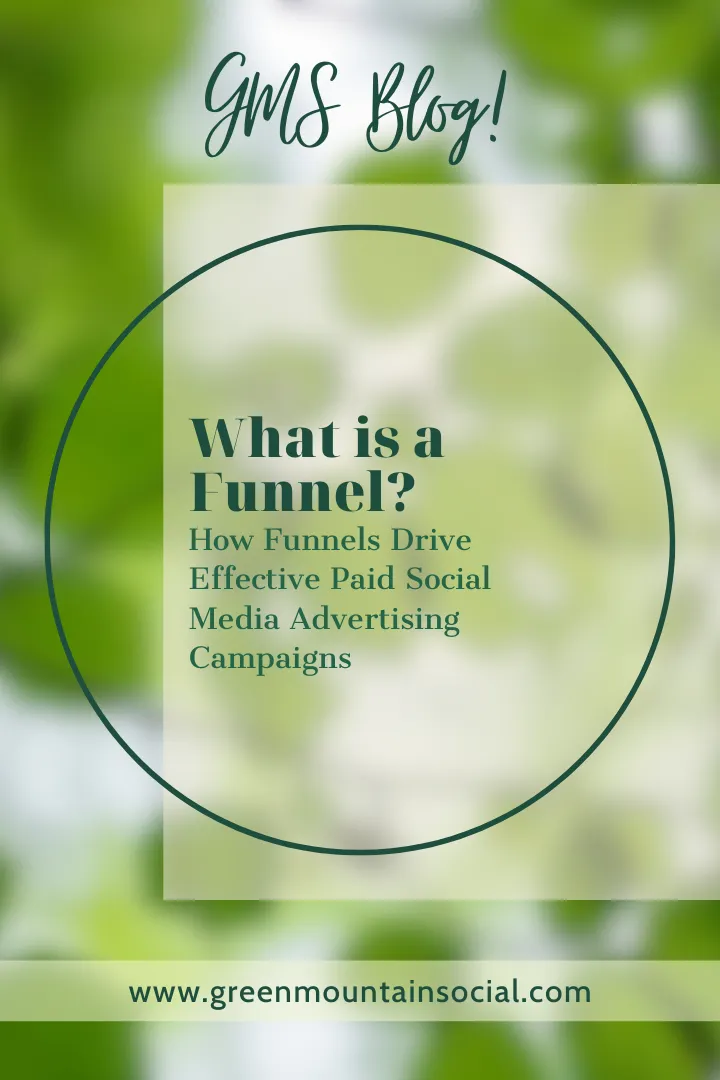
What is a Funnel? How Funnels Drive Effective Paid Social Media Advertising Campaigns
In the realm of digital marketing, the concept of a funnel is essential. A funnel illustrates the journey potential customers take from discovering your brand to becoming loyal clients. It serves as a visual metaphor that helps marketers understand and optimize the path to conversion, ensuring each stage of the customer journey is effectively catered to. In this blog post, we will explore what a funnel is and how it drives successful paid social media advertising campaigns. Ultimately leading to a more successful marketing strategy.
Understanding Funnel Stages
A funnel can be broadly divided into three stages: top, middle, and bottom.
Top of Funnel (ToFu): This is the awareness stage, where potential customers encounter your brand for the first time. Activities here focus on attracting a broad audience through content like blog posts, social media updates, and paid ads. The objective is to provide content and information that generates awareness and sparks interest with those who are interested in what you have to offer.
Middle of Funnel (MoFu): At this stage, the focus shifts to engagement and consideration. Here, the audience is already familiar with your brand and is evaluating its value. Content such as webinars, eBooks, and case studies plays a pivotal role. The aim is to nurture leads by providing valuable information that addresses their needs and concerns.
Bottom of Funnel (BoFu): This is the decision stage, where your audience is ready to make a purchase. Testimonials, demos, and special offers can help convert these prospects into customers. The goal is to provide compelling reasons to choose your product or service over competitors.
How Funnels Drive Effective Paid Social Media Advertising Campaigns
Funnels are crucial in creating successful paid social media advertising campaigns. By understanding the different stages of the funnel, marketers tailor ad content to meet the specific needs and interests of your audience at each stage.
Targeted Advertising: A well-structured funnel allows for more precise targeting. At the top of funnel, ads will focus on brand awareness and reach a larger, more general audience. As potential customers move to the middle of funnel, ads become more specific, addressing particular pain points and showcasing how your product or service can solve their needs and challenges. Finally, at the bottom of funnel, retargeting ads remind prospects of what they looked at on your site, encouraging them to take the final step to purchase.
Cost Efficiency: An effective funnel also makes your advertising more cost-efficient. By guiding prospects through a well-defined path, you reduce wasted time and ad spend on uninterested audiences. Each stage of the funnel functions with purpose, optimizing your budget by focusing on high-intent leads as they get closer to conversion.
Measurable Results: Funnels provide measurable and actionable insights. By tracking key performance indicators (KPIs) at each stage of the funnel, marketers identify strengths and weaknesses in their campaigns. This data-driven approach enables constant improvement, ensuring that your resources are allocated to strategies that yield the highest return on investment.
Enhanced Customer Experience: Finally, a well-executed funnel improves the overall customer experience. By delivering relevant content and messages tailored to the needs of the audience at each funnel stage, you build trust and credibility. This customer-centric approach increases the likelihood of conversion and fosters long-term loyalty.
Final Thoughts
Understanding and implementing a funnel-based approach is vital for driving effective paid social media advertising campaigns. By recognizing the distinct stages your audience goes through and tailoring your ad content accordingly, you boost conversion rates, optimize ad spend, and enhance customer experience, ultimately leading to a more successful marketing strategy. Remember, it's not just about getting people in the door; it's about guiding the right prospects through a journey that turns them into loyal customers. See you at the bottom of the funnel!
TIP FOR THE WEEK: Over the past 3 weeks, we’ve covered key marketing concepts together, starting with understanding organic social media, digital marketing, and now, understanding the marketing funnel. Take 15-minutes this week to read each post and jot down thoughts as they pertain to your business. How are you connecting with those who know of your business, and are interested in what you have to offer? How are you currently reaching new prospects? Who are your ideal clients and customers?
It’s ok to not have all of the answers right now. It IS important to be thinking about where you are with your marketing efforts currently, and making steady progress towards implementing a strategy that consistently connects with your marketing funnel.
COMING NEXT WEEK: A Guide for Small and Medium-Sized Business Owners: Connecting Digitally with Existing Customers and Those Familiar with Your Business the first of a 5-part series focusing on fundamental strategies to connect with those interested in what you have to offer. See you next week!
When you’re ready, here are 3 ways to learn more about us, and how we can help:
1. Learn more about Heather & Aly and how and why Green Mountain Social came to be here.
2. Familiar with our services? Learn more
3. Are we a good fit? Schedule a free strategy session with us. We’ll take a look at your website and social profiles come prepared with feedback and tips to improve your online and social presence!

What is a Funnel? How Funnels Drive Effective Paid Social Media Advertising Campaigns
In the realm of digital marketing, the concept of a funnel is essential. A funnel illustrates the journey potential customers take from discovering your brand to becoming loyal clients. It serves as a visual metaphor that helps marketers understand and optimize the path to conversion, ensuring each stage of the customer journey is effectively catered to. In this blog post, we will explore what a funnel is and how it drives successful paid social media advertising campaigns. Ultimately leading to a more successful marketing strategy.
Understanding Funnel Stages
A funnel can be broadly divided into three stages: top, middle, and bottom.
Top of Funnel (ToFu): This is the awareness stage, where potential customers encounter your brand for the first time. Activities here focus on attracting a broad audience through content like blog posts, social media updates, and paid ads. The objective is to provide content and information that generates awareness and sparks interest with those who are interested in what you have to offer.
Middle of Funnel (MoFu): At this stage, the focus shifts to engagement and consideration. Here, the audience is already familiar with your brand and is evaluating its value. Content such as webinars, eBooks, and case studies plays a pivotal role. The aim is to nurture leads by providing valuable information that addresses their needs and concerns.
Bottom of Funnel (BoFu): This is the decision stage, where your audience is ready to make a purchase. Testimonials, demos, and special offers can help convert these prospects into customers. The goal is to provide compelling reasons to choose your product or service over competitors.
How Funnels Drive Effective Paid Social Media Advertising Campaigns
Funnels are crucial in creating successful paid social media advertising campaigns. By understanding the different stages of the funnel, marketers tailor ad content to meet the specific needs and interests of your audience at each stage.
Targeted Advertising: A well-structured funnel allows for more precise targeting. At the top of funnel, ads will focus on brand awareness and reach a larger, more general audience. As potential customers move to the middle of funnel, ads become more specific, addressing particular pain points and showcasing how your product or service can solve their needs and challenges. Finally, at the bottom of funnel, retargeting ads remind prospects of what they looked at on your site, encouraging them to take the final step to purchase.
Cost Efficiency: An effective funnel also makes your advertising more cost-efficient. By guiding prospects through a well-defined path, you reduce wasted time and ad spend on uninterested audiences. Each stage of the funnel functions with purpose, optimizing your budget by focusing on high-intent leads as they get closer to conversion.
Measurable Results: Funnels provide measurable and actionable insights. By tracking key performance indicators (KPIs) at each stage of the funnel, marketers identify strengths and weaknesses in their campaigns. This data-driven approach enables constant improvement, ensuring that your resources are allocated to strategies that yield the highest return on investment.
Enhanced Customer Experience: Finally, a well-executed funnel improves the overall customer experience. By delivering relevant content and messages tailored to the needs of the audience at each funnel stage, you build trust and credibility. This customer-centric approach increases the likelihood of conversion and fosters long-term loyalty.
Final Thoughts
Understanding and implementing a funnel-based approach is vital for driving effective paid social media advertising campaigns. By recognizing the distinct stages your audience goes through and tailoring your ad content accordingly, you boost conversion rates, optimize ad spend, and enhance customer experience, ultimately leading to a more successful marketing strategy. Remember, it's not just about getting people in the door; it's about guiding the right prospects through a journey that turns them into loyal customers. See you at the bottom of the funnel!
TIP FOR THE WEEK: Over the past 3 weeks, we’ve covered key marketing concepts together, starting with understanding organic social media, digital marketing, and now, understanding the marketing funnel. Take 15-minutes this week to read each post and jot down thoughts as they pertain to your business. How are you connecting with those who know of your business, and are interested in what you have to offer? How are you currently reaching new prospects? Who are your ideal clients and customers?
It’s ok to not have all of the answers right now. It IS important to be thinking about where you are with your marketing efforts currently, and making steady progress towards implementing a strategy that consistently connects with your marketing funnel.
COMING NEXT WEEK: A Guide for Small and Medium-Sized Business Owners: Connecting Digitally with Existing Customers and Those Familiar with Your Business the first of a 5-part series focusing on fundamental strategies to connect with those interested in what you have to offer. See you next week!
When you’re ready, here are 3 ways to learn more about us, and how we can help:
1. Learn more about Heather & Aly and how and why Green Mountain Social came to be here.
2. Familiar with our services? Learn more
3. Are we a good fit? Schedule a free strategy session with us. We’ll take a look at your website and social profiles come prepared with feedback and tips to improve your online and social presence!
COPYRIGHT © 2025 GREEN MOUNTAIN SOCIAL. ALL RIGHTS RESERVED.




